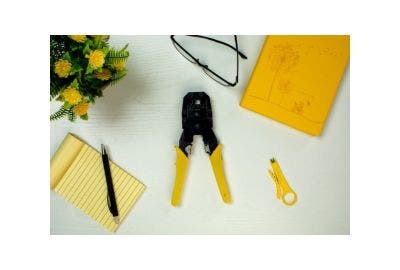For any professional electrician, it is almost impossible not to have as part of your essential tools of the trade, a wire stripper.
One of the first steps when rewiring will involve the need to correctly prepare wire cabling as part of any basic or intricate wiring tasks.
However, the types of wire strippers on the market can range from those ideal for completing simple jobs in the home to specialised and precision equipment which is designed for experienced professionals.
What Is A Wire Stripper?

A wire stripper is a small hand-held tool that is used to remove the insulation from electric wires. These portable hand-held tools are extremely popular among electricians and even DIYers for removing the insulation to replace or repair the wire.
Heamar offers several different wire strippers with knife-type blades, including the Stripmaster and Custom Stripmaster. Models from IDEAL are perfect for precision wire stripping. Heamar also stock and sell thermal wire strippers from HOTweezers, which are like tweezers but generate heat to easily cut through wire insulation.
Wire strippers are available in various shapes and sizes and usually have serrated teeth, which help to strip the wires. It is important to get the correct wire stripper for the gauge of wire you are stripping.
Wire strippers have a series of labelled holes that match the wire gauges specific to that stripper. When you insert the wire into the correct hole and squeeze the stripper's handles together, it precisely slices through the plastic insulation without damaging the wire.
Types Of Wire Stripper

Wire strippers come in different types, such as manual, automatic, pneumatic and adjustable, each designed to perform specific tasks. The type of wire stripper you use will depend on the gauge and type of wire you are working with, as well as the level of precision required for the task.
Hand-held wire strippers are one type of stripping tool which are commonly used for smaller gauge wires and cables. However, for larger and more complex jobs, an electric wire stripper may be a more suitable option.
Manual Wire Strippers
When needing to carry out the simplest of wire stripping tasks, having a pair of reliable manual wire strippers which provides minimal force and effort for the job may be enough.
These normally have spring-loaded handles, which are self-opening and feature a safety lock.
Adjustable Strippers
Adjustable wire strippers usually have two types of adjustments. One that can automatically adjust to the wire, or for more precision stripping, manual adjustments can also be made. The Xuron Adjustable Wire Stripper is ideal for simple household lighting projects.
Pistol Grip Wire Stripper
With self-adjusting blades, the pistol grip style is designed to grip and strip wiring simultaneously in one motion.
Steel Armoured Stripper
For robust armoured cables containing steel, copper, or aluminium shielding, this stripper with a reinforced blade will stand up to the task.
Insulated Stripper
With VDE-certified industry-standard handles, these are the ideal insulated premium wire strippers for protection from electrostatic discharge.
Triple Action Stripper
This type of tool has three different cutting options - spiral, linear, and rotary - which can handle various materials and types of wires and cables.
Sheath Stripper
When handling sheathed cables with two or more core cables running through, a sheath wire stripper is simple, easy to use, designed for cutting only the material required and features auto-adjustment for different wire diameters.
Laser Wire Strippers
Laser wire strippers are a high-end option for precise insulation removal, especially for cabling with narrow diameters, tough insulation, or specialist applications, such as medical equipment.
One of the most important benefits is minimal contact with the wire, and by selecting an appropriate laser type, it is possible to eliminate potential damage to the conductor or shield.
Automatic Wire Strippers
This type of wire stripper is designed to cut through and strip wire sheathing with just one squeeze of the tool's handles.
How Do I Use A Wire Stripper?
Although numerous different wire strippers are available, the process for using wire strippers is generally the same, or at least very similar. This is the standard process for using wire strippers:
Determine the wire gauge and type
Firstly, you need to identify the gauge of the wire to be stripped. You can find this printed on the insulation. The gauge will be stated as a number – you should also note whether the wire is solid or stranded.
Match the wire to the tool
Next, you must match the wire gauge with the corresponding hole on the wire stripper. This step is important because if you choose a hole that is bigger than the wire gauge, the insulation will not be fully cut and it’ll be difficult to strip. If you choose a hole that is smaller than the wire gauge, the wire may be nicked and so compromised.
Set the wire
You must now set the wire into the wire stripper on the blade side of the correct hole. Slowly press the handles together and the stripper will cut through the insulation on the wire.
Remove the insulation
Use a slug remover to remove the insulation from the wire. The IDEAL slug remover is the product Heamar recommends (part number: 45-333).
Ensuring you have the correct wire strippers for the job, take a look at our full range of hand tools at Heamar for a welcome addition to your toolbox.



























